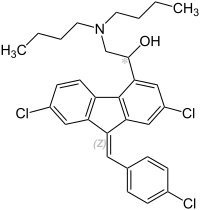Lumefantrine
| Structural formula | |||||||||||||||||||
|---|---|---|---|---|---|---|---|---|---|---|---|---|---|---|---|---|---|---|---|

|
|||||||||||||||||||
| Structural formula with incomplete stereochemistry | |||||||||||||||||||
| General | |||||||||||||||||||
| Non-proprietary name | Lumefantrine | ||||||||||||||||||
| other names |
|
||||||||||||||||||
| Molecular formula | C 30 H 32 Cl 3 NO | ||||||||||||||||||
| External identifiers / databases | |||||||||||||||||||
|
|||||||||||||||||||
| Drug information | |||||||||||||||||||
| ATC code | |||||||||||||||||||
| Drug class | |||||||||||||||||||
| properties | |||||||||||||||||||
| Molar mass | 528.94 g · mol -1 | ||||||||||||||||||
| solubility |
hardly soluble in water, oil and most organic solvents , soluble in unsaturated fatty acids |
||||||||||||||||||
| safety instructions | |||||||||||||||||||
|
|||||||||||||||||||
| As far as possible and customary, SI units are used. Unless otherwise noted, the data given apply to standard conditions . | |||||||||||||||||||
Lumefantrine is a substance that is toxic to plasmodia .
It is used as drug in a fixed combination with artemether for the treatment of by Plasmodium falciparum induced malaria used.
Pharmacological properties
Lumefantrine probably interferes in the plasmodia with the breakdown of haemin, which is toxic to the parasites, to form haemozoin . The absorption of the lipid-soluble substance is greatly facilitated in the case of oral administration by a meal that is as rich in fat as possible. Lumefantrine has a half-life of four to six days. Lumefantrine is metabolized in the liver by the enzyme cytochrome P450 3A4 .
Preparations and Uses
Lumefantrine is used exclusively as a combination preparation for the therapy of malaria. Lumefantrine monopreparations are not approved worldwide.
The main focus for the use of artemether-lumefantrine combination preparations is the treatment of uncomplicated tropic malaria , especially with plasmodia that are resistant to other drugs such as chloroquine .
Stereoisomerism
In addition to a Z -configured double bond, lumefantrine also has a chiral center, the configuration of which is not fixed. The racemate (1: 1 mixture of enantiomers ) is used as the medicinal substance .
Trade names
- in a fixed combination (Lumefantrine 120 mg with Artemether 20 mg) as Riamet u. a. in D , A , CH , GB , F , S , NL and as Coartem u. a. in USA , ZA
See also
Individual evidence
- ^ The Merck Index. An Encyclopaedia of Chemicals, Drugs and Biologicals . 14th edition, 2006, p. 970, ISBN 978-0-911910-00-1 .
- ↑ There is not yet a harmonized classification for this substance . A label for 2- (dibutylamino) -1 - [(9Z) -2,7-dichloro-9 - [(4-chlorophenyl) methylidene] -9H-fluoren-4-yl] ethane is shown, which is derived from a self-classification by the distributor -1-ol in the Classification and Labeling Inventory of the European Chemicals Agency (ECHA), accessed on July 7, 2020.
- ↑ ABDA database (as of December 4, 2009).